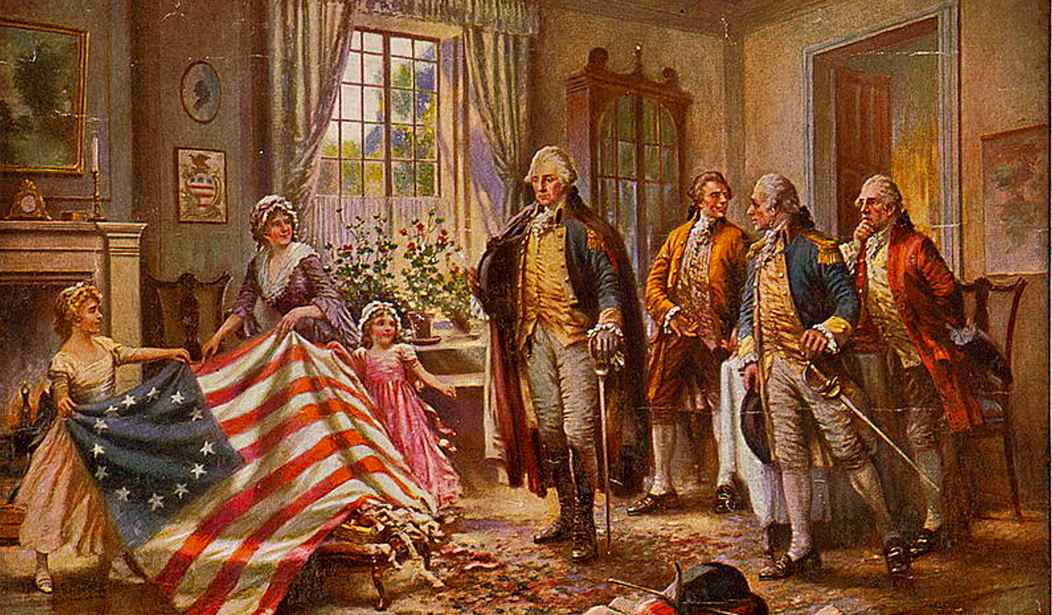One day, George Washington and some members of the Continental Congress came calling to Betsy Ross in Philadelphia. Washington asked her to make a new flag for our nation; it would have red and white stripes, with white five-pointed stars on a field of blue up in the left-hand corner. Betsy cheerfully agreed to the task, and pretty soon we had our brand new flag. Or so the story goes…
Well, that’s the legend, and almost all of it is just that, a nice story with very little fact behind it.
In reality, on June 14, 1777, the Continental Congress passed the first of three “Flag Acts” that would stipulate what a new national flag would look like.
This Flag Act said that we would indeed have a banner with alternating red and white stripes, but it did not say which way the stripes would go … horizontal or vertical. And yes, there would be a field of blue with stars … but Congress did not think to mention how many points the stars would have. Four? Five? Six?
Nor did the law say which direction the stars would point. Nor was there any statement about stars arranged in a circle, or in any configuration. We just take it for granted today, but our country was just starting out back then, and many people were concerned with weightier things … like winning a war.
In 1776, George Washington had two flags in his camp. One had the alternating red and white stripes, but in the upper-left-hand corner there were no stars; instead it was the British Union Jack! That flag was a clear symbol that the Americans still considered themselves to be descendants of Great Britain, while definitely separating themselves from the mother country at the same time. Washington’s other flag flew over his headquarters. It was simply a blue banner with white stars. Interestingly, the stars were not five-pointed but rather six-pointed — resembling the Star of David!
What about Betsy Ross? Well, she was a real person, living in Philadelphia during that time period. She and her husband ran an upholstery business, but tragically he was killed in a munitions accident in 1776. She bravely toiled on, keeping the upholstery business going. We do know that she was an expert seamstress, often repairing uniforms for the Continental Army. There is even a record from the Navy Board of Pennsylvania, May 29, 1777, stating that Elizabeth Ross (Betsy) needed to be paid for sewing ships’ flags. (Pennsylvania had a Navy? Who knew?)
However, there is no historical evidence whatsoever that Washington or any member of Congress visited her and asked her to make a national flag. Historians today are almost certain that the whole story is fiction. In fact, there was no story about Betsy Ross and the flag until 1870 — almost 100 years after the fact! William Canby, Betsy’s grandson, started telling the story in 1870 that his grandmother made the first U.S. flag because of a personal request from George Washington. (When historians look at the diaries and other writings of Washington at this time, there is zero mention of such a story.)
A few decades later, a painting by C.H. Weisgarber did not help straighten things out. The now famous painting, done in 1909, shows Betsy proudly showing off the new Stars and Stripes (complete with five pointed stars arranged in a circle) to the honored General Washington. Incredibly, this painting made its way into almost every children’s history book throughout the country!
So who did create the first Stars and Stripes? Probably Congressman Francis Hopkinson of New Jersey, but even that has some mystery surrounding it. All we have substantiating that story is a bill he submitted to Congress. In the bill, he said he wanted remuneration for having created our first national flag. The payment he wanted was a cask of wine! Ha! Congress refused to pay him, stating that he was not the only one who created the flag; it was a collaborative effort. Who else was in on the creation? We simply don’t know.
So, from 1777 all the way until 1960, our flag evolved. Here in this nice little video you can enjoy seeing many different versions of Old Glory:
The Flag Act of 1794, signed by President Washington, allowed for fifteen stripes and fifteen stars for the admission of Vermont and Kentucky into the Union. This would be the only U.S. flag with more than thirteen stripes, and this flag would be the famous “Old Glory” that flew over Fort McHenry in the War of 1812. Here it is, the Star Spangled Banner that our National Anthem is about:
https://www.youtube.com/watch?v=a4og572QJho
In 1818, Congress passed its third Flag Act, stipulating that from now on, there would only be thirteen stripes, representing the original thirteen colonies, and a new star would be added for each additional state. Congress continued to pass future acts specifying exactly how the stars were to be arranged, which direction they would be pointed, and so on. Finally, on July 4, 1960, the United States saw the last change to our flag. The fiftieth star was added when Hawaii was admitted to the Union.
This week on June 14, celebrate Flag Day! Remember the wonderful, inspiring, glorious history of our nation and what we stand for! Get out that flag and display it proudly! God bless the United States of America.
Here are a few Marines showing the right way to honor an American flag.









Join the conversation as a VIP Member